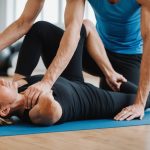Essential Strength Training Moves for Rock Climbers
Strength training is indispensable for climbers aiming for performance enhancement. Each move in a training regimen serves a purpose, especially in preparing the body for the physical demands of climbing. It is about balancing power, endurance, and agility to transition effectively on the rock face.
Key muscle groups targeted include the forearms, back, and core. Strengthening the forearms helps maintain grip during long ascents, while a strong back supports pulling actions and body stability. Core strength is crucial as it stabilises the body, facilitating better control and reducing energy expenditure. Effective workout moves for rock climbing target these areas with precision.
Also to discover : Mastering the Art of the Spike: Essential Techniques for Volleyball Players to Boost Impact
Among these moves, pull-ups are fundamental for building upper body strength, mimicking the pulling motions in climbing. They condition the back and shoulders for sustained and intensive use. Planks and hanging leg raises, on the other hand, fortify core muscles, aiding in stabilisation during complex manoeuvres. By carefully integrating these exercises, climbers build endurance and power, vital for overcoming challenges on the rock.
Thus, strength training for climbers not only fortifies the body but significantly enhances climbing performance. These exercises give climbers the edge needed to scale harder routes, ensuring every muscle contributes to a successful climb.
Also to read : Top Techniques to Conquer Pre-Race Anxiety for Competitive Runners
Detailed Exercise Descriptions
Understanding the proper exercise techniques is crucial for success in any fitness routine. Below are guidelines and insights to achieve effective results.
Pull-Ups
To execute a pull-up effectively, begin with an overhand grip, hands shoulder-width apart. Engage your core, and stabilize your body as you pull yourself up until your chin is above the bar. Lower with control to avoid injury. Common mistakes include swinging the body or using momentum rather than strength. To improve, practice controlled movements and strengthen your grip. Variations such as assisted pull-ups or weighted pull-ups can adapt this exercise for different skill levels.
Dead Hangs
Dead hangs are simple yet effective for building grip strength. Hang from a bar with arms fully extended and shoulders engaged. Aim to maintain a steady hold, focusing on controlled breathing. Avoid shrugging shoulders upwards, as this can cause strain. For improvement, gradually increase duration. Variations like single-arm hangs or adding grip challenges work great for progression.
One-Arm Pull-Ups
One-arm pull-ups require significant upper-body strength. Grasp the bar with one hand and keep the other close by your side. Pull up so your chin rises above the bar, keeping the movement steady. A common mistake is relying on momentum instead of strength. Training tips include mastering pull-up variations and focusing on unilateral exercises. For beginners, assisted one-arm pull-ups offer a gradual skill improvement.
Benefits of Strength Training for Climbers
Strength training is pivotal for climbers aiming to maximise their performance gains. By incorporating an organised routine of climbing workouts, climbers can achieve notable increases in overall climbing strength. Enhanced strength enables climbers to tackle more challenging routes, as muscles are more conditioned to handle the demands of climbing.
One of the standout benefits of climbing workouts is enhanced grip strength and endurance. Grip strength is crucial for climbers, as it supports the ability to hold onto climbing holds for extended periods without fatiguing. Regular strength exercises focusing on the forearms, hands, and fingers can significantly improve grip endurance, directly contributing to climbing efficiency.
Another essential advantage is injury prevention through balanced muscle development. Climbers often face the risk of injury due to repetitive strain on specific muscle groups if they don’t engage in comprehensive strength training. By promoting balanced muscle growth, climbers can reduce the risk of injuries such as tendonitis or muscle strains. This balanced development ensures that all muscle groups are equally prepared to support the climbing activity.
- Increased overall climbing strength
- Enhanced grip strength and endurance
- Improved balance for injury prevention
Incorporating these workouts into a climber’s routine not only enhances their skills but also ensures a safer and more fulfilling climbing experience.
Expert Insights and Testimonials
Ideas and advice from climbers can be incredibly valuable. Professional climber input highlights the importance of combining specific training with climbing practice. Notable climbers often emphasize that climbing proficiently requires constant adaptation and evolution of techniques.
Expert advice suggests incorporating strength training into regular routines. Many climbers report that developing core, grip, and leg strength has markedly improved their climbing performance. For example, renowned climbers advocate for exercises that target specific muscle groups essential for climbing, such as finger strength and upper body stability.
One climbing community member shared how engaging in regular strength training not only improved their route completion success but also reduced injury risk. Another climber pointed out that being part of the climbing community provides access to a wealth of shared knowledge, tips, and motivational support, enhancing both technical skills and mental resilience.
Climbing community endorsements often praise a balanced approach to training that includes dynamic exercises such as pull-ups, dead hangs, and planks. This input is echoed by industry experts, who recommend these exercises to build endurance and power. Testimonials from seasoned climbers underscore the importance of tailored workouts as a key factor in elevating climbing capabilities.
Tips for Proper Technique
Understanding the importance of proper form in rock climbing is crucial not only for performance but also for injury avoidance. Climbing with incorrect posture can lead to strain and injuries, which may deter progress. Maintaining a stable core and ensuring limbs are correctly placed helps in distributing weight effectively, thus preserving energy.
Posture and Form
A good climbing posture begins with body tension; engage your core and keep your hips close to the wall. This alignment maximizes climbing efficiency as it allows for seamless transitions between movements. Using your legs more than your arms reduces fatigue and extends your climbing sessions.
Injury Prevention Strategies
To steer clear of common injuries, avoid sudden, dynamic movements in favour of controlled, deliberate motions. Regular stretching and strength training can improve flexibility and enhance muscular support. It’s beneficial to listen to your body; rest when necessary to prevent overuse injuries.
Maximizing Exercise Effectiveness
Incorporating variety in your training routine can also boost effectiveness. Try exercises that focus on different muscle groups engaged in climbing. Focus on the quality rather than quantity of repetitions. This strategic approach not only builds strength but also ensures the longevity of your climbing experience.
Variations and Progressions for All Skill Levels
Climbers of all experiences have diverse options to enhance their skills. Beginner training lays the foundation by focusing on safe practices and gradual strength building. Initially, new climbers should concentrate on improving grip strength, flexibility, and balance with low-risk routes and exercises. Progressive training exercises, such as bouldering on increasingly challenging paths, can methodically advance a climber’s ability while minimising injury risks.
As climbers graduate to intermediate levels, the emphasis shifts to more advanced climbing moves. These might include dynamic exercises like dead hangs and lock-offs which test endurance and enhance core strength. Engaging in such variations is vital for those who have surpassed basic climbing skills and wish to challenge themselves further.
For seasoned climbers, striving for peak performance involves an array of complex techniques. Advanced moves such as dynos (dynamic leaps) and mantling (using upper body strength to push onto a ledge) are paramount. Climbing variations at this level are about precision, power, and superior conditioning. By embracing these techniques, climbers refine their abilities, adapting to the ever-increasing demands of the sport.
Ultimately, understanding one’s limitations and pacing progress can prevent injuries and promote an enjoyable climbing journey across all skill levels.











